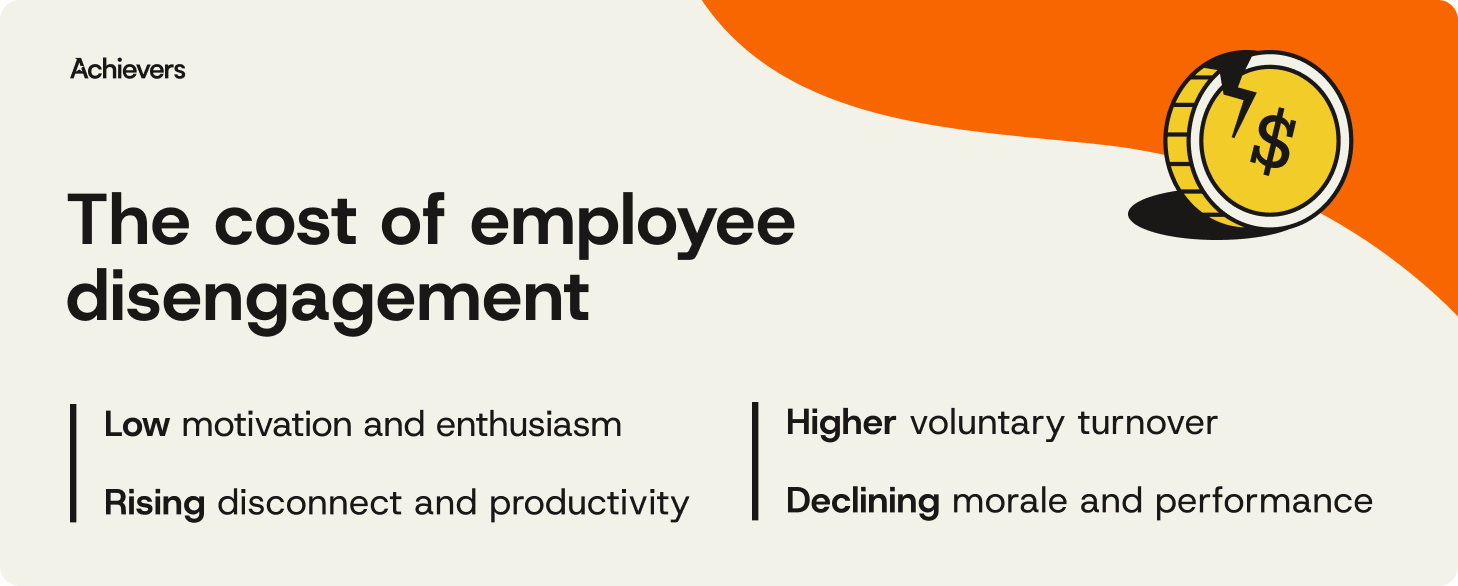Table of contents
Create a culture that means business™
Schedule a demo with an Achievers solution expert today.
Employee disengagement is on the rise — but it doesn’t have to be the end of the story.
In 2024, global engagement dropped to 21%, according to Gallup’s State of Global Workforce Report — the steepest decline since the early days of the pandemic. The cost? A staggering $438 billion in lost productivity. That’s a lot of missed deadlines, half-hearted meetings, and top performers quietly heading for the door.
But disengagement isn’t a dead end — it’s a chance to course-correct. With the right strategies, teams can reconnect, cultures can rebound, and people can find purpose in their work again. Sometimes, it starts with something as simple as a “thank you” that actually means something.
In this blog, we’ll break down the cost of employee disengagement, unpack what’s driving it, and explore how to re-engage your people — one meaningful moment at a time.
The real cost of employee disengagement
When recognition is missing, disengagement creeps in — and the costs add up fast. From low motivation to rising turnover, here’s what employee disengagement really looks like (and why it pays to act early):

1. Lack of motivation and enthusiasm
Disengagement doesn’t always look dramatic. Sometimes it’s just someone doing the bare minimum. The spark’s gone. Employees who once leaned in now log in, zone out, and quietly disconnect. Gallup’s data shows that only 21% of employees globally are engaged at work. That leaves a whole lot of people running on energy-saving mode — and not because they’re efficient.
2. Rising disconnect and productivity
Disengaged employees aren’t just less productive — they’re less present. They skip the optional brainstorm. Turn cameras off. Stop contributing. And according to Achievers Workforce Institute (AWI), when employees feel disconnected from company values, their sense of purpose — and performance — drops. It’s not just a culture issue. It’s a momentum killer.
3. Higher voluntary and “regrettable” turnover
You don’t always see it coming, but you feel the loss. When top performers walk out, it’s rarely about money alone — it’s about meaning, growth, and feeling valued. AWI found that 63% of employees who are meaningfully recognized at least monthly rarely think about looking for a new job. Translation? A little consistent appreciation can go a long way in keeping your best people right where they are.
4. Decline in team morale and performance
Disengagement doesn’t stay contained — it spreads. When a manager checks out, their team feels it. In Gallup’s report, they found that disengaged leaders actively drag down engagement on their teams, creating a ripple effect of lower morale, missed goals, and more turnover.
And while culture can’t be fixed overnight, it can be tracked — and shaped. Investing in recognition and culture-building efforts now isn’t just proactive; it’s protective. Platforms like Achievers make it easier to spot disengagement early through real-time engagement data, and course-correct with recognition that actually lands.
Key reasons for employee disengagement
Disengaged employees usually aren’t the problem — they’re the result. When people don’t get what they need to succeed and feel valued, motivation fades. Let’s look at some of the biggest drivers of disengagement and how to start turning them around.
- Poor leadership: When leaders are unclear, unapproachable, or uninvested, it sets the tone — and not in a good way. And Gallup’s reporting is clear, disengagement often starts at the top. The fix? Develop leaders who connect, communicate, and actually care.
- Lack of recognition and appreciation: People don’t need a parade — they just want to know their work matters. When recognition is rare or generic, it sends the message that effort is invisible. But when it’s regular, meaningful, and tied to what matters most? That’s when people feel seen — and stay.
- Limited growth opportunities: Nobody wants to feel like they’ve hit a dead end at work. When employees don’t see a future with your company, they’ll start imagining one somewhere else. Career conversations, talent development paths, and stretch opportunities all show that you’re invested — and worth investing in.
- Unclear expectations: If employees don’t know what’s expected, how can they deliver? Ambiguity kills momentum. Clear goals, regular check-ins, and actionable feedback help employees stay aligned, engaged, and confident in their role.
- Workload and burnout: When workloads feel endless and downtime is non-existent, engagement takes a hit. Employees don’t need a yoga subscription — they need realistic expectations and breathing room to do their best work.
How to re-engage a disengaged employee
If you treat employee disengagement like a conversation instead of a correction, you’re already headed in the right direction. Here’s how managers can start rebuilding trust, motivation, and momentum — one step at a time.
Start with action, not assumptions
- Lead with curiosity, not confrontation: A one-on-one should feel like a check-in, not a correction. Approach the conversation with genuine interest in what’s going on — and a clear signal that you’re here to support, not to criticize.
- Ask open-ended questions that invite honesty: Ditch the “How are things?” small talk. Try: “What’s felt off lately?” or “What’s one thing I could do differently to support you?” The goal is to understand what’s underneath the disengagement, not to rush to fix it.
- Build a short-term plan and a long-term roadmap: Re-engagement doesn’t happen overnight. Collaborate on a plan that tackles immediate blockers — and sets a path toward something more meaningful. Progress, even in small doses, rebuilds trust and motivation.
- Follow through with consistency and accountability: Don’t let the momentum fade after the meeting. Set regular check-ins, track progress, and recognize effort. When employees know you’re invested for the long haul, they’re more likely to re-engage — and stay engaged.
Use recognition to rebuild trust and motivation
When trust slips, recognition can bring people back in. Not the generic kind — the kind that feels intentional, specific, and human. That’s where the real engagement magic happens. And it’s exactly what the Achievers platform is built to support.
- Make it timely, specific, and personal: Recognition shouldn’t feel like a vague shoutout at the end of a long meeting. Achievers makes it easy to deliver appreciation in real time — tied to actual behaviors, moments, and outcomes — so it lands when it matters most (not three performance reviews later).
Bonus: If you’re wondering whether your recognition is hitting the mark, start with this manager checklist. It’s a quick gut check — no slide deck needed. - Balance top-down with peer-to-peer: Recognition shouldn’t just flow downhill. With Achievers, everyone has the power to recognize — from executives to interns. The result? A culture where appreciation comes from all directions, not just the manager’s playbook.
- Tie recognition to values and growth: It’s not just what gets recognized — it’s why. Achievers lets you tag recognitions to core values, learning goals, or milestones, so employees don’t just feel appreciated — they feel aligned and invested in something bigger.
- Use recognition as a launchpad for feedback and connection: A great “thank you” can start an even better conversation. Achievers integrates with tools your team already uses, so recognition moments can spark meaningful check-ins, nudge follow-ups, or open the door to coaching — without adding another meeting to the calendar. It also creates space for open, honest conversations before disengagement turns into turnover.
Employee disengagement is costly — recognition is the fix
Disengagement isn’t a death sentence — but it will bleed your budget, morale, and momentum if you ignore it. The good news? Most employees aren’t asking for magic. They’re asking to be seen, supported, and reminded that their work matters.
That’s where recognition comes in. Not the generic, once-a-quarter shoutout — but meaningful, well-timed appreciation that reflects real effort. When it’s done consistently (and done right), recognition doesn’t just boost motivation. It changes behavior. It rebuilds trust. It helps people care again.
With Achievers’ recognition platform, that kind of recognition becomes part of the everyday — baked into workflows, aligned to values, and backed by data that helps leaders keep engagement on track. Reversing disengagement doesn’t require a hero — just better habits and the right tools to build them.



